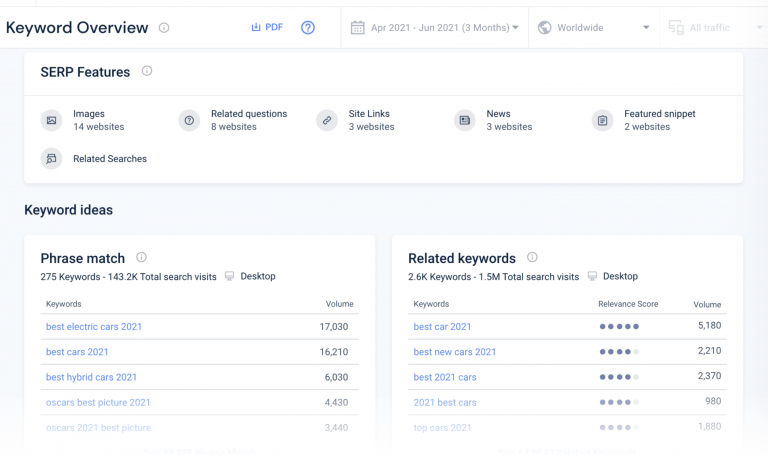The Pro’s Guide to Featured Snippets

The game’s changed; the number one SERP spot’s no longer the target. The new goal? Position zero. If you’ve ever looked for apple pie ingredients or asked how to change a tire, you’ve come across SEO’s holy grail – featured snippets.
Every time you search, your search engine strives to return the most relevant content. Some queries result in a clear and concise answer at the top of the page called a featured snippet.
What are featured snippets?
So, what are featured snippets? Here’s the lowdown.
Featured snippets, or answer boxes, are short extracts of text at the top of the search results that quickly answer your query. The content’s usually pulled from indexed web pages with the most useful content.
They’re optimized for your search terms and the top websites will regularly conduct comprehensive keyword research to target as many related terms as possible.
Being ‘featured’ often results in additional brand exposure in organic search results, higher CTR (click-through rates), and an increase in search traffic. As an SEO expert, knowing how to leverage featured snippets is key to your (or your client’s) long-term success.
In this article, we’re going to break down:
- What featured snippets are
- Why they’re important
- How you can use Similarweb to optimize your content and achieve higher SERP rankings
Why are featured snippets important for SEO?
Standing out from the competition and driving specific keyword-based traffic to your website is harder than ever.
In today’s digital-first world, websites that can accurately and concisely answer the most frequently asked questions about a subject win the battle to get featured.
For example, a quick Google search for “how to tie a Windsor knot”, serves up this handy video answer box as the top result:
What’s really neat is that Google automatically selects the part of the video that talks about how to tie a Windsor knot.
Searching the “20 best-selling cars of 2020”? Here’s an up-to-date list of them, courtesy of featured snippets:
As snippet boxes are in premium positions on Google’s search results page, they can improve your website’s visibility and generate more quality traffic. Over time, as you continue to build and publish more content based on the term your featured snippet ranks for, you can build authority and a repository of information — ultimately solidifying your website’s position.
That’s why featured snippet opportunities are so important. Let’s talk about Google’s featured snippets.
Types of featured snippets
There are many different types of featured snippets with new ones emerging with new Google algorithm updates. Here are some you might see.
Definition
Definitions commonly solve “what is” or “what does” questions. The answer should provide a clear, direct definition or description, given as text, and can even include an image.
Here’s it in action. Ever wondered “what does a doctor do?”
It’s short, to the point, and easy to understand. You could show this to anyone and they would immediately understand what a doctor does.
Lists
Lists serve up everything from recipes to instructions and are also used to rank things in order, like TV shows and movies.
This featured snippet for ‘the steps to make bread’ gives readers a quick breakdown of what needs to be done to make dough. It’s simple and effective.
Tables
Google can pull statistics and metrics from a web page and display them as a table, like this:
Videos
For queries that could do with a little more visual representation, featured clips are returned. These short videos directly answer the question and are usually taken from longer films. Videos are quickly becoming one of the top featured snippet opportunities.
How to optimize for featured snippets
If you want to maximize the reach of a piece of content, you’ll want to get as many featured snippets as possible. But how?
Almost all featured pages already rank at the top of Google. So if you’re already ranking highly for related search queries, you’re in the best position to get featured.
But you don’t have to top a search results page to get featured. It’s all about the quality of your content and how well it answers the user’s search query.
Use this step-by-step guide and get started with featured snippets optimization:
1. Start with on-page SEO
While there’s no magic ‘feature’ button for your web pages, remember your page has to rank highly for a query to even be considered.
Review your SEO practices and start optimizing your content and user experience as best as possible. Don’t just identify new keyword terms and neglect your HTML:
- Ensure your content flows and is relevant to the searcher’s query
- Check the page’s loading speed backlinks to useful information
- Update your meta tags
- Make sure all images have alt tags
- Include keywords in your H1s, H2s, and H3s
2. Answer each question concisely
Keep it short, clear, and to the point. Most featured snippets are between 40-50 words.
But remember, Google will pull the information it needs from your article to answer a query. So you don’t have to shorten your articles — just make sure they answer the most pertinent questions and break them down with logical headers and subheadings.
Pro tip: Answer the specific question right away and then elaborate further with additional information.
We’ve recently updated our Digital Marketing Intelligence platform to include SERP Features for Keywords to help with this.
With Similarweb, you can analyze SERP features and keyword positions to understand what features are showing for a given keyword and if you, your competitors, or clients are showing up within these.
3. Consider how you structure your content
Google loves structured content — it makes it easier for its crawlers to decipher the content, and for searchers to follow along and find what they’re looking for.
So use headings, bullet points, knowledge graphs, key takeaways, and lists in your articles. Don’t forget to reference your statistics and consider adding a table of contents (along with anchor text) to help visitors quickly access the information they’re looking for.
4. Focus on related questions
Remember, the vast majority of us have different search tendencies, from how we write an initial query to what we do if it’s too broad or specific.
So fire up a keyword research tool, and type your original phrase in — then see what other related terms come up with search volume (ideally with low competition). These are how people are finding content like yours.
Once you know what other people also ask, you can optimize your content for them. This will help you drive more traffic to a piece of content and, hopefully, get it on the first page and featured in a snippet box.
Of course, you’ll need the right tools.
Similarweb’s Keyword Research and analysis tools, for example, provide access to fresh and accurate keyword data that can help you optimize your strategy. It’s reliable (we use actual user search queries, rather than scraping methods), scalable (with over 1 billion keywords, and counting), and fresh (we spot keywords and trends before anyone else).
Pro tip: Need help conducting competitive keyword research in under five minutes? This article has your FAQs covered.
5. Manage your content hierarchy
It’s better to lay a solid foundation for your future success now, rather than later. How? By starting with a “generic” target keyword, one that encompasses a particular problem, issue, or product/service you provide.
For example, if you sell website analytics to marketers, your overall umbrella term is “website analytics”. This becomes the main category for your pillar piece. More specific queries, like “what is the best website analytics software?” or “how to set up website analytics”, become the long-tail keyword articles that sit under that umbrella and link back to your pillar page.
With this approach, it becomes easy for website visitors and Google to understand what your articles are about and how they relate to a specific topic.
6. Track, track, track
Using the right tools, you can track each web page’s performance for specific keyword terms.
Similarweb’s SEO competitive analysis, for example, allows you to uncover your traffic and engagement gaps across all marketing channels. You can quickly discover growth opportunities based on what works best for your competitors’ marketing strategies, prioritize keywords, and discover what’s generating traffic, or trending at the moment.
How to track and optimize your featured snippets
We’ve highlighted some of our platform’s features. Here’s how it can help you boss your content marketing and track and optimize your featured snippets.
-
SERP features update
Be more data-driven with your SERP strategy. Analyze SERP features and keyword positions to understand which SERP features are showing for a specific keyword (and whether you, your competitors or clients are ranking for them). Don’t forget, SERP features dominate and draw searchers’ attention, and have the potential to increase CTR and organic traffic.
-
Competitive SEO and content analysis
Review the traffic share of your keywords by geography, branded vs. non-branded, search type, competitiveness, and more. You can even create more effective content by identifying trending keywords and the most viewed content on your site with top organic pages.
-
More keyword data
If you’re operating in a transactional industry, we’ve added another keyword research tool to our growing list of SEO functions. We can now offer on-site keyword search data from Amazon. Using this capability, you can generate thousands of high-intent keyword ideas, helping you to target the right people at the right time.
Your next big opportunity
Now you’re a featured snippets pro and know how to target that coveted position zero, it’s time to get to work building an effective, high-impact strategy.
Success starts with the right plan and the right tools — and Similarweb is just what you need to get started.
Our Digital Marketing Intelligence solution can empower your SEO strategy.
Featured snippets FAQs
What is a featured snippet?
A featured snippet is a short extract of a longer text that appears at the top of the search result, answering your query quickly.
Why are featured snippets important for SEO?
Featured snippets are important because they can improve your website’s visibility and organic traffic, allowing you to build authority.
What are the types of snippets?
There are several types of featured snippets, including, lists, tables, and videos.
The #1 keyword research tool
Give it a try or talk to our marketing team — don’t worry, it’s free!















